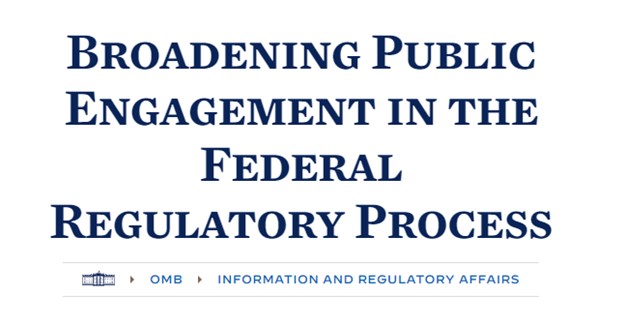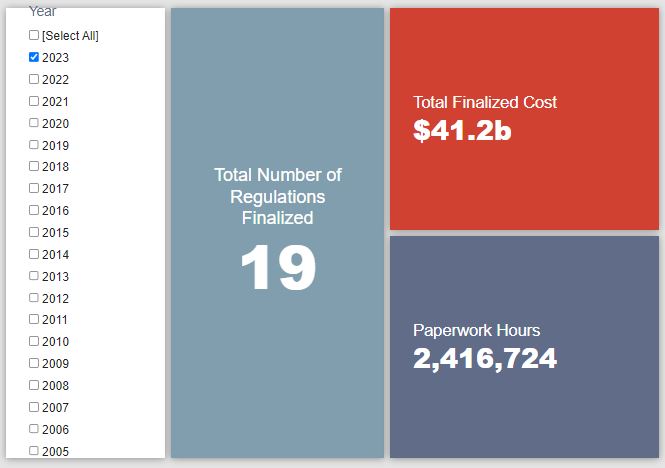Week in Regulation
February 13, 2023
School Meal Guidelines Proposal Headlines Otherwise Mild Week
The first full week of February was fairly tepid but for one proposed rule. There were eight rulemakings with some quantifiable economic impact, but most were relatively modest. A Department of Agriculture (USDA) update to the nutritional standards for school breakfasts and lunches provided most of the week’s action in terms of new costs and paperwork. Across all rulemakings, agencies published $1.6 billion in total costs and added 938,367 annual paperwork burden hours.
REGULATORY TOPLINES
- Proposed Rules: 34
- Final Rules: 65
- 2023 Total Pages: 9,088
- 2023 Final Rule Costs: $41.2 billion
- 2023 Proposed Rule Costs: $17 billion
NOTABLE REGULATORY ACTIONS
The most consequential rulemaking of the week was USDA’s proposed rule regarding “Child Nutrition Programs: Revisions to Meal Patterns Consistent With the 2020 Dietary Guidelines for Americans.” The proposal seeks to make a series of updates to the regulatory standards established for school meal programs. The main items involve lowering the amount of sodium and added sugars in the typical school meal. USDA expects these changes to increase costs for affected school authorities in terms of administrative burdens as well as the need to shift to inherently more expensive food items to meet the updated standards. The agency currently gives a range of potential costs that averages out to $247 million annually, or nearly $1.5 billion overall across a seven-year implementation period.
TRACKING THE ADMINISTRATIONS
As we have already seen from executive orders and memos, the Biden Administration will surely provide plenty of contrasts with the Trump Administration on the regulatory front. And while there is a general expectation that the current administration will seek to broadly restore Obama-esque regulatory actions, there will also be areas where it charts its own course. Since the AAF RegRodeo data extend back to 2005, it is possible to provide weekly updates on how the top-level trends of President Biden’s regulatory record track with those of his two most recent predecessors. The following table provides the cumulative totals of final rules containing some quantified economic impact from each administration through this point in their respective terms.
![]()
The only final rules with any measurable economic impact from last week were a set of airworthiness directives from the Federal Aviation Administration that added up to a grand total of roughly $8 million in costs. As such, the Biden Administration totals barely moved at all. There was a similar level of stagnation in the Obama Administration. In the Trump Administration, however, there was a notable spike in costs and paperwork – enough, in fact, to drive that administration’s cost total back into positive territory. The reason for this dramatic jump was a tax regulation regarding the “Qualified Business Income Deduction” that imposed 25 million hours of paperwork annually and $9.6 billion in total costs.
THIS WEEK’S REGULATORY PICTURE
This week, the Office of Information and Regulatory Affairs (OIRA) seeks input on how the public can be more easily involved in the regulatory process.

Source: https://www.whitehouse.gov/omb/information-regulatory-affairs/broadening-public-engagement-in-the-federal-regulatory-process/
OIRA has now established a site that both outlines its most recent preliminary recommendations and solicits further comment on how federal agencies can increase the quality and effectiveness of public input into the regulatory process. OIRA’s current findings and considerations follow an “engagement session” it hosted last fall under the auspices of this administration’s Open Government plan. This new stage in the effort raises three broad categories of current recommendations and four main areas on which “OIRA invites feedback.”
The three categories of recommendations essentially boil down to: A) increasing the public’s understanding of the regulatory process, B) providing relevant material in a more accessible format, and C) expanding the level of outreach between agency and affected stakeholders. The first item focuses on providing educational tools and charts across agency content to give the public a better idea of its role in the process. The second item focuses on making sure agency actions are easily discernable to persons with limited subject matter knowledge and available across a variety of modes to allow the greatest breadth of input. Finally, the third recommendation area directs agencies to be more dynamic and innovative in how they alert the affected public to either current or potential actions.
The primary issues on which OIRA seeks further input as it considers refining these recommendations include: A) How efficacious would these recommendations be in terms of increasing the quality of the process? B) Are there any notable gaps in these recommendations – “especially for underserved communities” – that involve even further action? C) What are the best examples already out there that could stand as a template for other agencies? D) How can agencies more effectively leverage connections with private groups to engage more proactively with said groups’ membership?
Interested parties have until March 10, 2023, to submit their contributions on these matters “as written feedback or recorded audio and video submissions” to [email protected].
TOTAL BURDENS
Since January 1, the federal government has published $58.2 billion in total net costs (with $41.2 billion in new costs from finalized rules) and 8.1 million hours of net annual paperwork burden increases (with 2.4 million hours in increases from final rules).











